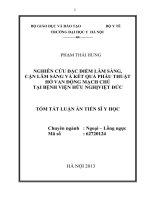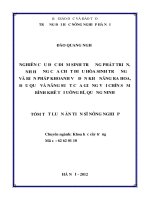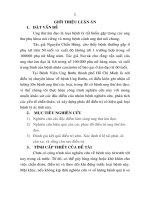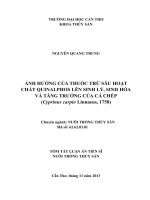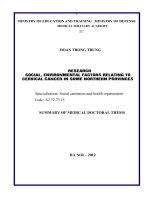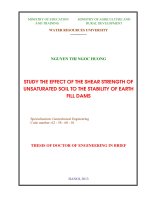tóm tắt luận án tiếng anh nghiên cứu đặc điểm lâm sàng, cận lâm sàng và kết quả phẫu thuật hở van động mạch chủ tại bệnh viện hữu nghị việt - đức
Bạn đang xem bản rút gọn của tài liệu. Xem và tải ngay bản đầy đủ của tài liệu tại đây (228.64 KB, 38 trang )
MINISTER OF
EDUCATION AND
TRAINING
HEALTH OF
MINISTER
HA NOI MEDICAL UNIVERSITY
Pham Thai Hung
STUDY CLINICAL CHARTESRICS, SUB
CLINICAL CHARTESRICS AND RESULT
OF SURGERY AORTIC VALVE
REGURGITATION IN THE FRIENTSHIP
HOSPITAL VIETNAM- GERMANY
SUMMARY OF THE DOCTOR THESIS
Majors : Surgery – thoracic
Code : 62720124
1
WORK TO BE COMPLETED IN:
HANOI MEDICAL UNIVERSITY
Science instructor: 1. Assoc. Prof. Dr. Le Ngoc Thanh
2. Prof. Dang Hanh De
The Science Reviewer 1: Assoc. Prof. Dr. Dang Ngoc Hung
The Science Reviewer 2: Assoc. Prof. Dr. Pham Nguyen Son
The Science Reviewer 3: Assoc. Prof. Dr. Đoan Quoc Hung
The thesis will be protected in council dots thesis Hanoi University Medical.
In……hour, date month Year 2014
2
CAN FIND OUT THE THESIS AT
- National Library
- Library of Hanoi Medical University
- Institute of Medicine Information Central Library
3
RESEARCH PROJECTS RELATED
1. Pham Thai Hung, Le Ngoc Thanh. “Character of valve regugitation in surgery and preoperative
ultrasonographyof the aortic valve insufficency in the Viet – Duc Hospital” Journal of practical
medecine 1-2014
2. Pham Thai Hung, Le Ngoc Thanh. “Research clinical characteristics and preoperative
ultrasound in patients with aortic valve insufficiency in Viet-Duc Hospital” The Vietnamese Journal of
cardiovascular and Thoracic Surgery 12-2013
3. Pham Thai Hung, Le Ngoc Thanh. “Earnly - term Evaluation of Aortic Valve Replacement valve
in Viet Duc Hospital” Journal of Vietnamese medecine 8-2011
4. Pham Thai Hung, Le Ngoc Thanh. “Commenting on the state of artificial heart valves after
surgical aortic valve replacement in Viet – Duc hospital” Journal of Vietnamese medecine 8-2011
5. Pham Thai Hung, Le Ngoc Thanh. “Characteristic lesions and early outcome after surgical aortic
valve disease in Vietnam-Germany Hospital” Journal of practical medecine 3-2006.
4
BACKGROUND
Aortic valve regurgytation is the leaflet not sealed, reflux of blood from the aorta to the left ventricle
chamber during diastole. This disease was first described Vieusens the eighteenth century.
These lesions are relatively common heart valve, caused by many factors such as abnormal anatomic
pathology at valve, aortic root In developed countries like the U.S., Europe has about 10% of the elderly
with aortic valve lesions and approximately 10% of patients with valvular heart disease, ranked No. 5 in the valvular
lesions. The leading cause is believed to be due to degenerative valve, approximately 10-15% of people over age 60
with aortic valve insufficiency with varying degrees.
For developing countries and Vietnam the leading cause of heart valve disease in young people as a result of
rheumatic heart. According to Nguyen Phu Khang, aortic injury due to lower accounts for 25% of patients with
valvular lesions, in the majority of cases of aortic valve insufficiency caused Rheumatic fever accompanied by
stenosis mild to moderate level. Aortic valve insufficiency in our study consists pure aortic regurgitation and
aortic regurgitation combine stenosis but AR are still mostly.
In aortic valve insufficiency divided into 2 groups: acute and chronic aortic valve regurgitation. The acute
aortic valve insufficiency (usually after injury, infection endocarditis) consequences very early congestive heart
failure. Meanwhile aortic valve insufficiency chronic occur lasting several months, several years with symptoms
progressing quietly. In Kirklin, severe aortic valve insufficiency lifetime lasts from 3-10 years. Borer shows that,
aortic valve regurgitation appeared clinical symptoms, but left ventricular function was normal without surgery
is 80% over 5 years living. In Vietnam, Nguyen Lan Viet et al, aortic valve lesions were asymptomatic when the
rapid decline of survival without surgery. With the valve regurgitation degree mild - moderate 85-95% live more
5
than 10 years, but moderate – servere despite medical treatment, the survival rate after 5 year is about 75% and
after 10 years: 50%. Mortality rates increased linearly with annual patient clinical symptoms: 9.4%, no
symptoms was 2.8%. Surgery is one of the treatments to tackle aortic valve to prolong survival and improve
quality of life for patients. There are many methods: valve repair, valve replacement, valve transplant The
choice of surgical time, surgical approach depends not only on the degree of valve damage, heart function that
depends on the patient's condition.
Stemming from the fact that we conducted on the topic: " Study clinical characteristics, Sub-clinical and
results of surgery aortic valve regurgytation in the Friendship Hospital Vietnam - Germany" to the
following objectives:
1. Describe the clinical characteristics and their sub- clinical aortic valve regurgitation surgery in the Vietnam-
Germany Friendship Hospital.
2. Evaluate the results of open surgery patients the aortic valve in German hospitals Vietnamese friendship.
* The layout of the thesis:
Thesis include: 142 page, book distribution and issue 2 page, 2 page conclusion. Thesis includes four
chapters: Chapter I Overview 37 page, Chapter 2 Subjects and methods Studies 14 page, chapter 3 research
results 32 page, chapter 4 discussion 38 page. Thesis 50charts, 32 graphs and images. 21creference in
Vietnamese, 160 English reference. The appendix consists image illustrates treated patients, medical research,
patient invites re-examination, the patient list.
* Practical significance and contributions of the thesis: In the study we find that lesions aortic valve
regurgitation are characterized by: quietly devlopment, it has no symptoms, lesion was mainly in the leaflet
valves and the less common was aortic root lesion. In valvular lesions by measuring inflammation (rheumatic
6
heart, endocarditis ) had large proportion and combination with stenosis valve
Patients with a much reduced left ventricular function (EF <30%) should still surgery, but the mortality rate
has higher, functional heart improved less than but clinically obvious improvement.
Valve replacement is still a top choice in aortic valve regurgitation. Biological valve tends to be expanded to
specify when has the advantage: not use anticoagulants, has gradient pressure through the valve lower than
mechanical valves
Left ventricular function has recovery in the first 6 months after surgical manifestations of left ventricular
volumes are decreased and left ventricular muscle mass index are reduced.
Chapter 1. OVERVIEW
1.1. Clinical anatomy of aortic root and valve
The aortic root: be calculated from the grip of the left ventricular internal valve leaves to the Valsalva sinus
junction and ascending aorta (ventriculo-arterial junction). The aortic root is considered as a part of the left
ventricular, function of the structure supporting the aortic valve, the valve leaves, coronary sinus, annulus.
1.1.2. Anatomy of aortic valve
1.1.2.1. Norman Anatomy of aortic valve: The aortic valve consists primarily of three semilunar leaflets. Right
coronary leaves, left coronary leaves; non coronary leaves. Average Width: right coronary cup: 25.9 mm, non
coronary cup: 25.5 mm, left coronary cup: 25,0 mm.
1.1.2.2. Abnorman Anatomy of aortic valve: Unicuspid, Bicuspid and Quadricuspid aortic valve.
1.3. The causes of aortic valve insufficiency chronic
1.3.1. Aortic root pathology: Unexplained dilatation of the aortic root, aortic annulus, valsalva sinus and the
ascending aorta and also during the meeting:
7
- Marfan Syndrome.
- Inflammation of the aorta due to syphilis
- Ehlers-Danlos syndrome.
- Reiter's syndrome.
- Injuries or aneurysm of the aortic wall
1.3.2. Leaf disease in aortic valve:
- Rheumatic valvulopathy.
- Calcareous degeneration or degeneration mucous
- Valsalva sinus aneurysm expansion.
- Abnormalities antomy: unicuspid, bicuspid and quadricuspid
- Infective endocarditis
1.3.3. Pathology is not in the root and aortic valve
Ventricular Septal Defect (Laubry Pezzi syndrome) and high blood pressure system.
1.4. Diagnosing aortic valve insufficiency
1.4.1. Clinical
1.4.1.1. Functional symptoms: often do not show symptoms for a long time.
+ Angina: appeared in patients with severe AR.
+ Shortness of breath on exertion: increased depending on the severity of heart failure.
+ Degree of heart failure according to NYHA classification.
+ Blood pressure is normal if mild aortic valve insufficiency, servere aortic valve insufficiency, high
systolic blood pressure, diastolic blood pressure decreased, creating discrepancies greater blood pressure, can
8
cause out for signs such as: Musset, Miller, Hill, Corrigan’s, Quincke,
1.4.1.3. Physical symptoms:
Listening Heart: The heart rate is normal, to late stage: tachycardia
- T1 heavy and fuzzy they severe aortic valve and left ventricular dysfunction ; T2 often blurred, split.
- Diastolic murmur: III-IV intercostal space left breast side.
- Systolic flow murmur: III-IV intercostal space left,
- Austin Flint murmur: may be present at the cardiac apex in severe AR and is a low-pitched.
1.4.2.1. Hematology and biochemistry: generally to assess body condition, liver, kidneys, heart failure
1.4.2.2. Chest x ray shows the image to dilated cardiomyopathy, cardiac chest index increased, left ventricular
relaxation. Dilatation of the ascending aorta pathologies: Marfan syndrome, aortic dissection
1.4.2.4. ECG: Often left atrial thickness and left ventricular hypertrophy, in left axis deviation, diastolic
volume
overload, arrhythmias occurring at the last stage and mostly atrial fibrillation.
1.4.2.5. Echocardiography: help the diagnosis and indication of surgery. This can be done through the chest
ultrasound or ultrasound of the esophagus.
+ Assessment of the anatomy of the aortic leaflets and the aortic root: anatomy of the aortic root, annulus
and leaflets
+ Determination of the valve regurgytation: based on color Doppler and Doppler ultrasound.
+ Characterization of LV size and function
- Characterization of LV size:
The thickness of the left ventricle and left ventricular diameter
Left ventricular mass was calculated based on the formula of Devereux left ventricular hypertrophy: >
9
134g/m2 in men and > 110g/m2 in women.
- Left ventricular systolic function: the index is calculated from the 2D and TM: Ejection fraction (EF): The
most widely index used in cardiology.
- Left ventricular diastolic function
1.4.2.6. Cardiac Catheterization: indicated when there is suspicion of lesions coronary artery. Angiography for
male patients> 40 years old and women > 50 years of age
1.4.2.7. The other exploration methods: computerized tomography, magnetic resonance imaging is widely used
to assess the damage in the leaves, the status of the valve lesion, valve leaf cell, thickness
1.5. Treatment
1.5.1 Medical treatment
*. The vasodilator: Improved clinical status and preoperative hemodynamics in patients with left ventricular
dysfunction appears not functional symptoms It should not be long-term treatment when surgery is indicated.
*. Angiotensin converting inhibitors: reduce volume and increase volume open ejection Left ventricular
assist restructuring, maintain or increase ejection fraction, left ventricular mass reduction.
*. Patients had functional symptoms appear, they must surgical not only medical treatment.
1.5.2 Surgical Treatment
1.5.2.1. Indications: based on the recommendations of the American Heart Association 2006 and the Vietnam
Cardiovascular Association 2008.
Class I
1. AVR is indicated for symptomatic patients with severe AR irrespective of LV systolic function.
2. AVR is indicated for asymptomatic patients with chronic severe AR and LV systolic dysfunction (EF
0.50 or less) at rest.
10
3. AVR is indicated for patients with chronic severe AR while undergoing CABG or surgery on the aorta or
other heart valves.
Class IIa
AVR is reasonable for asymptomatic patients with severe AR with normal LV systolic function (EF greater
than 0.50) but with severe LV dilatation (end-diastolic dimension greater than 75 mm or end-systolic dimension
greater than 55 mm).
Class IIb
1. AVR may be considered in patients with moderate AR while undergoing surgery on the ascending aorta.
2. AVR may be considered in patients with moderate AR while undergoing CABG.
3. AVR may be considered for asymptomatic patients withsevere AR and normal LV systolic function at rest
(EF greater than 0.50) when the degree of LV dilatation exceeds an end-diastolic dimension of 70 mm or end-
systolic dimension of 50 mm
1.5.2.2 The method of surgical treatment of aortic valveinsufficiency.
*. Plasty valve: have advantages: The mortality rate after surgery is low, no need for anticoagulants, good
long-term survival. But for aortic valve repair is often difficult to have to consider the possibility of valve repair
or no longer.
* Aortic valve replacement
+ Surgical aortic valve replacement: removal of aortic valve, but instead an artificial valve (mechanical or
biological), is the only choice to be almost absolute, mortality after valve replacement surgery from 2-3%.
+ Percutaneous aortic valve replacement: through the femoral artery, subclavian artery or cardiac apex,
under the guidance of the X-ray brightening screen and echocardiography through the esophagus.
11
+ Transplantation valve: Autologous transplantation valve (Ross operation) or homografted. The valves are
more durable, gradient pressure through the valve low than other biological valves.
1.5.3. The postoperative complications:
1.5.3.1. The common complications of open heart surgery
*. Bleeding after surgery: Bleeding is considered unusual exceed 250 to 300 ml / h for the first 2 hours or
100-150ml / h later.
*. Pleural effusion, pericardial: is a common complication of cardiac surgery, having about 50-64% of
cases and damage heart function in 0.8 to 6%
*. Infection: Infection is less common in cardiac surgery.
- Wound infection: occurs in 1-2% of patients with open sternum surgery.
- Sternal Wound: With an incidence rate of 1-4%, is a rarely occurring complication, but may show a
mortality rate of up to 50%.
1.5.3.2. Complications associated with artificial valve replacement.
*. Artificial valve regurgytation:
Cause: the calcified around valves, infection, artificial valves loosen off within or fault of the surgeon and
degenerative biological valve insufficiency.
*. Artificial valve stenosis:
Cause: The status of shrinkage annulus valve, the valve can not accommodate large size, intimal
hyperplasia within valve stenosis.
*. Artificial valve thrombosis: do not use anticoagulant dosage or improper use.
- Stuck valves artificial is dangerous complications, usually happens for mechanical valves.
12
1.5.3.3. Complications related to valve repair.
*. Aortic valve regurgytation: after valve surgery leaves no closing secret should remain open valve
condition. However the case have a hole or tear valve leaves, should be replaced with artificial valves.
1.5.3.4. Other complications:
+ Atrial Fibrillation: many cases postoperative atrial fibrillation.
+ Conduction disturbances: 2-3% after valve replacement surgery.
+ Endocarditis: According Steaphanie, endocarditis rate of 3.9% for mechanical valves and 3.2% with
biological valves.
+ Stroke: about 4% of stroke after valve replacement surgery.
+ Postoperative heart failure: encounter rate of 2.6%.
Chapter 2
SUBJECTS AND METHODS
2.1. Subjects of study
Includes patient injury aortic valve insufficiency was diagnosed and treated at the Department of
Cardiovascular Surgery Vietnamese German hospital.
2.1.1. Selection criteria for patients and medical research.
Includes all patients regardless of the age, aortic valve insufficiency had surgical indications:
+ Be the first surgery.
+ Clinical information, clinical complete
+ Diagnosing aortic valve regergytation is given:
13
Symptoms: Diastolic murmur: in III-IV intercostal space left breast side.
Ultrasound: Assessment of the aortic leaflets
. Severity of AR level: divided into 4 levels of valve: mild, moderate, moderate – severe and severe.
+ Do not exclude cases with mild, moderate aortic stenosis valve, but just the main symptoms regurgytation
and aortic valve insufficiency associated systemic disease, coronary artery disease.
2.2. Research Methodology
2.2.1. Research Methodology: descriptive cross-sectional clinical, longitudinal monitoring, advanced research.
Study period from 1/2006 to 12/2010. The patients in the group were receiving a consistent procedure
follows:
14
2.2.1.1. Preoperative:
* Physical exam: General characteristics:
- Age, Gender
- The clinical symptoms:
- The accompanying systemic disease (diabetes, chronic lung)
* Sub clinic:
+ Blood tests: hematology, blood biochemistry, clotting.
+ Chest X-ray straight: chest cardiac index
+ ECG: evaluation heartbeat, conduction disturbances atrioventricular block; increased left ventricular load,
ventricular hypertrophy
+ Echocardiography:
- Assessing the damage of leaf valve: The anatomy of the aortic leaflets and nature of injuries leaves.
- Assessment of valve regurgytation class:
- Cardiac function: LV volume, EF and LV muscle mass
+ Cardiac catheterization and coronary angiography: in patients with myocardial ischemia, patients> 50 years
old (female),> 45 years old (male).
Indications for surgery: based on the recommendations of the American Heart Association 2006 and
Vietnam Cardiovascular Association 2008.
2.2.1.2. During surgery we noted:
+ Leaf valve lesions and aortic root condition:
+ Other lesions: aortic wall status and coronary stenosis
15
+ Valve is used: mechanical, biological, homograft or tube valve
2.2.1.3 After surgery:
Postoperative period:
+ Condition of the heart, (Equal or arrhythmia, murmur ).
+ The complications and postoperative complications: Postoperative bleeding; Infection (wound,
sternum ); Pneumonia; Heart Failure….
+ Artificial valve and complications related to the operation .
Patient status at hospital discharge:
+ Clinical Status
+ Complications: incision, the sternum, artificial valve
+ Ultrasound after surgery:
- Assess the status of artificial valves and complications
- Left ventricular function and left ventricular recovery after surgery
Rating results after discharge: Inspection time: 1 month after surgery, 6 months, 1 year, 3 years, 5 years.
Content inspection:
- Clinical evaluation through surgery outcomes:
+ Functional symptoms: chest pain, shortness of breath and heart abnorman sounds; blood pressure.
+ Status wound: infection, inflammation of the sternum
+ Complications: bleeding, embolism, stuck valves, heart failure
+ Mortality (cause of death)
16
- Sub- clinic:
Echocardiography: Status artificial valve and postoperative complications and the recovery of left
ventricular function.
- The rate of re-operation ( surgical reasons, the surgical method).
2.3. Data processing.
Summarizing the data obtained to draw the characteristics of aortic regurgytation.
Data processing method biostatistics: EPI-INFO 2002.
Chapter 3
RESULTS
From 1/2006 -12/2010 our 67 cases surgical aortic valve regurgitation.
3.1. General characteristics.
Age: In 67 patients studied was 70 years old maximum, minimum age is 16 years old, mean age: 45.8 ±
12.8.
Sex: 49 males accounted for 73.1%, accounting for 26.9% female 18.
3.2. The clinical lesions before surgical aortic valve.
3.2.2. The clinical symptoms
Dyspnea on exertion accounted for 82.09%, and chest pain 13.43%
Blood pressure: systolic blood pressure mean: 138.34 ± 13.21mmHg
Diastolic blood pressure on average 59.23 ± 10.12 mmHg, blood pressure gradient between the maximum and
17
minimum average: 65 ± 11.43.
Degree of heart failure patients in NYHA preoperative: 4.48% have no expression, 46.27% NYHA II,
35.82% NYHA III and 13.43% of patients with severe heart failure NYHA IV.
3.2.3. Subclinical
3.2.3.1. X-ray: 55 cases,( 82.09%) had cardiac index / chest > 55%.
3.2.3.2. ECG: sinus rhythm: 82.35%, LV over load 91.04%.
3.2.3.3. Ultrasound
+ The valve regergytation level: AR moderate:10,45%; AR moderate- severse 58,21%; AR sevese: 31.34%
and 22 cases combined with stenosis (mild to moderate): 32.84%.
+ The size of the heart chambers and other parameters
Table 3.13&3.14. A number of other parameters on preoperative echocardiography
Common AR pure
AR combine
AS
LV end-diastolic volumes(ml) 175,4 184, 8 171,5
LV end-systolic volumes (ml) 85,3 89,4 83,1
Left ventricular mass (g) 252,15 254,2 249,2
Left ventricular mass index (g/m
2
)
Male
Female
204,7
192,6
209,6
196,5
203,7
190,8
18
Comment: Left ventricular mass index was higher in the group valve regurgytation pure (mean difference
with p <0.05).
+ Left ventricular function: Ejection fraction average 53.4 ± 9.7, majority of patients with left
ventricular EF > 45: 59.7%, 7 cases with EF <30: 10.45%.
19
3.3. Reviews of surgery.
3.3.1 Characteristics damage valves, aorta during surgery.
Table 3.16. Causes of injury aortic valve insufficiency
Lesions (n=67) Rate (%)
Abnormal anatomy
Bicuspid 8 11,94
Quadricuspid 1 1,49
Lesions leaves
Leaves thick 59 88,06
Shrinking leaves 51 76,12
Calcified 35 52,24
Deformity leaves 5 7,46
Perforation leaves 3 4,48
Lesions the aortic root
Calcification annulus 5 7,46
Aortic root dilation 5 7,46
Lesions diferent Coronary artery stenosis 5 7,46
Comment: biscupid aortic valve: 11.94%, leaf lesions which are shrinking rolled: 76.12%,
3.3.2. The surgical approach
The surgical approach: Replacement: 67 cases, accounting for 100%. In the mechanical valve 53 cases
(79.10%), biological valves 12 cases (17.91%), Tube valves 2 cases (2.99%). Valve size: 23 cases accounted for
47.76%, size 21 (38.81%); 5 cases with coronary artery stenosis add to CABG surgery.
3.4. Postoperative Results
3.4.2. Postoperative Complications
Table 3.24. Several encounter complications after surgery
Complications n=67 Mechanic Biological
20
Bleeding reoperation 2
(2,99%)
1
(1,49%)
1(1,49%)
Effusion, pneumothorax 1
(1,49%)
0 1(1,49%)
Wound infection 7
(10,45%
3
(4.48%)
4
(5,97%)
Postoperation heart failure 6
(8,96%)
4
(5,97%)
2
(2,99%)
Mortality’s hospitalization 1
(1,49%)
1
(1,49%)
0
Comment: 2 cases of bleeding have to re-operation. 7 cases incision wound 10.45% and 1 case had severe heart
failure irreversible, dead: 1.49%.
3.4.3 Results of patients discharged from hospital
3.4.3.1.The clinical examination and echocardiography at discharge
Table 3.28. Clinical Results 7th day after surgery
Clinic n=66 Rate %
NYHA
I 30 45,45
II 21 31,82
III 11 16,67
IV 4 6,06
Systolic blood pressur (mmHg) 123,5
21
Diastolic blood pressur (mmHg) 78,4
Chest pain 5 7,58
Myocardial ischemia 2 3,03
Status of artificial valve: work well: 89.39%, 5 cases valve slightly regurgytation: 7.58% and 2 cases gradient pressure
through the valve>40 mmHg
Table 3.30. Comparison of ultrasonographic parameters
The parameters Pre- op
(n=67)
Post-op
(n=66)
p
LV end-diastolic volumes 175,4 105,4 0,0096
LV end-systolic volumes 85,3 46,5 0,0095
EF (%) 53,4 ± 9,7 52,6± 8,1 0,4774
The left ventricular mass (g) 252,15 ± 118,27 234,4 ± 120,2 0,1334
The left ventricular mass index (g/m
2
) 204,4 ± 69,3 192,9± 33,5 0,1052
Comment: The LV function postoperative EF 52.7 compared with 53.4 preoperative but the difference was not
statistically significant.
22
3.4.4. The test results after surgery
3.4.4.1. Examination 1 month after hospital discharge
Table 3.33. Results of clinical and ECG 1 month after surgery
The parameters n =66 Tỷ lệ (%)
NYHA I 38 57,58
II 22 33,33
III-IV 6 9,09
Chest pain 2 3,08
Heart arrhythmia 12 18,46
Heart murmur 5 7,58
Incision good healing 63 95,45
Wound infection 2 3,03
ECG Sinus heart 53 80,30
Heart arrhythmia 12 18,18
Comment: At 1 month after surgery, is still 9.09% of patients with difficulty breathing.
Table 3.34. Echocardiography after 1 month
Prosthetic heart valve n=66
Mechanic
(n=55)
Biological
(n=11)
Works well 59 50 (90,91%) 9 (15,38%)
23
Regergytate around the artificial valve 2 2 (3,64%) 0
Rergergytate in center 3 1 (1,82%) 2(1,54%)
Gradient max. through
the valve (mmHg)
Mechanic 53 22,8 ± 5,8
P=0,154
Biological 11 20,6 ± 8,4
Comments: gradient pressure through valve average 21.6 ± 6.3mm Hg
24
Table 3.35. Results of the echocardiographic parameters later 1 month
The parameters n Results p
EF (%) 66 55,2 ± 9,6
The left ventricular mass index g/m
2
)
Both
Mechanic
Biological
Tube valve
66
53
11
2
155,7 ± 48,6
154,1 ± 52,1
132,5 ± 36,4
158,2 ± 40,6
0,0512
Comment: LV systolic function of patients with good, with an average EF was 55.2 ± 9.6, LV mass
index 155.7 ± 48.6
3.4.4.2. After surgery 6 months: Results are as follows
+ Clinical Status
Table 3.36. Results of clinical symptoms after 6 months
Symptoms n=65 Rate (%)
Incision pain 8 12,31
Chest pain 2 3,08
Heart arrhythmia 12 18,46
Bleeding 1 1,54
NYHA I
II
III - IV
31
28
5
47,69
43,08
7,69
Mortality 1 1,54
25
